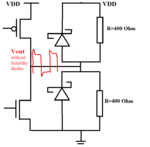hannover90
Member level 4
Why schould a Schottky diode be connected in parallel to resistor?
In some over voltage (or spikes) protections, a Schottky diode is used, which is connected in parallel to a resistor.
I can not understand the role of the resistor.
Could someone explain to me, please? Thanks
In some over voltage (or spikes) protections, a Schottky diode is used, which is connected in parallel to a resistor.
I can not understand the role of the resistor.
Could someone explain to me, please? Thanks
